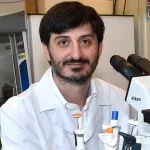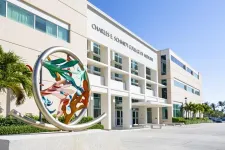(Press-News.org) CLEVELAND—With a new five-year, $3.2 million grant from the National Institute on Deafness and Other Communications Disorders, researchers at Case Western Reserve University and Mass Eye and Ear will study what causes acquired hearing loss (AHL) and seek new ways to protect against it.
AHL is among the most common health conditions affecting older adults, according to the Centers for Disease Control and Prevention. Although hearing aids can help, AHL has no known cure and, in many cases, scientists are still unsure of its exact cause.
AHL significantly impacts quality of life, leading to increased social isolation, depression and cognitive decline. Untreated hearing loss is associated with a higher risk of dementia, with even mild untreated hearing loss doubling the risk.
“We anticipate that if we are successful, this could point to new strategies to preserve human hearing by regulating mitochondrial calcium levels,” said Ruben Stepanyan, assistant professor in the Department of Otolaryngology at the Case Western Reserve School of Medicine.
Understanding hearing loss
An important factor in hearing is the health of cochlear hair cells—sensory cells in the inner ear that detect sound vibrations and send electric signals to the brain. These cells are packed with mitochondria, or microscopic energy-producing components.
Hearing loss may result from damage caused by malfunctioning mitochondria, according to previous peer-reviewed research. Hair-cell health depends on balanced calcium levels regulated, in part, by mitochondria. Loud noises can cause calcium levels to rise too high, stressing the cochlear hair cells.
This study will examine how calcium overload from noise exposure might damage cochlear hair cells contributing to hearing loss and identify novel therapeutic targets to treat it.
Part I
Researchers will use a particular type of mouse models more prone to calcium overload and early hearing loss to evaluate how overstimulation from loud sounds affects the structure and function of cochlear hair cells.
They will use advanced three-dimensional imaging technology—along with novel machine-learning-based 3D data analysis approaches—to examine the structure of mitochondria in these cells to understand how they change under stress.
Part II
Researchers will then test whether preventing calcium overload in mitochondria can protect hearing by testing other types of mouse models with reduced mitochondrial calcium to learn if they may be more resistant to noise damage.
“The ultimate goal is to find ways to prevent hearing loss related to noise exposure and aging, which could help millions of people protect their hearing as they age,” said Artur Indzhykulian, assistant scientist at Mass Eye and Ear's Eaton-Peabody Laboratories and assistant professor of otolaryngology at Harvard Medical School.
###
At Case Western Reserve, one of the nation's leading research universities, we're driven to seek knowledge and find solutions to some of the world's most pressing problems. Nearly 6,200 undergraduate and 6,100 graduate students from across 96 countries study in our more than 250 degree programs across arts, dental medicine, engineering, law, management, medicine, nursing, science and social work. Our location in Cleveland, Ohio—a hub of cultural, business and healthcare activity—gives students unparalleled access to engaging academic, research, clinical, entrepreneurial and volunteer opportunities and prepares them to join our network of 125,000+ alumni making an impact worldwide. Visit case.edu to learn more.
About Mass Eye and Ear
Massachusetts Eye and Ear, founded in 1824, is an international center for treatment and research and a teaching hospital of Harvard Medical School. A member of Mass General Brigham, Mass Eye and Ear specializes in ophthalmology (eye care) and otolaryngology–head and neck surgery (ear, nose and throat care). Mass Eye and Ear clinicians provide care ranging from the routine to the very complex. Also home to the world's largest community of hearing and vision researchers, Mass Eye and Ear scientists are driven by a mission to discover the basic biology underlying conditions affecting the eyes, ears, nose, throat, head and neck and to develop new treatments and cures. In the 2024–2025 “Best Hospitals Survey,” U.S. News & World Report ranked Mass Eye and Ear #4 in the nation for eye care and #6 for ear, nose and throat care. For more information about life-changing care and research at Mass Eye and Ear, visit our blog, Focus, and follow us on Instagram, Twitter and Facebook.
END
Florida Atlantic University’s Marcus Institute of Integrative Health has been awarded a monumental $6 million grant from the late Bernie Marcus and The Marcus Foundation to broaden its services, enhance educational programs, and expand community wellness initiatives, ultimately aiming to create a national model that demonstrates the effectiveness of comprehensive integrative health as the optimal approach for achieving overall well-being for everyone.
This latest grant to FAU from The Marcus Foundation, which was made prior to the passing of Marcus in early November, brings its total contributions for advancing integrative health to more than $10 million, ...
Researchers led by Uljana Kravčenko and her colleagues in the lab of Professor Misha Kudryashev, Group Leader of the In Situ Structural Biology lab at the Max Delbrück Center, have revealed new features of the molecular architecture of synaptic vesicles. Using cryo-electron tomography, the team was able to visualize SVs in 3D and confirm a potentially important protein-protein interaction. They also broadened our understanding of SV function and of how the vesicles are recycled. The study was published in the Proceedings ...
From the RMS Titanic to the SS Endurance, shipwrecks offer valuable — yet swiftly deteriorating — windows into the past. Conservators slowly dry marine wooden artifacts to preserve them but doing so can inflict damage. To better care for delicate marine artifacts, researchers in ACS Sustainable Chemistry & Engineering developed a new hydrogel that quickly neutralizes harmful acids and stabilized waterlogged wood from an 800-year-old shipwreck.
Wooden artifacts from shipwrecks are drenched with seawater, an environment that enables acid-producing ...
To study the effects of misinformation on attitudes, some social science experiments expose participants to false, misleading, or dangerous information. Most Institutional Review Boards require that such studies be followed by a debriefing session, in which participants are told that the information that was presented was not true. Katherine Clayton and colleagues sought to determine whether these debriefs can “undo” the effects of exposure to misinformation. The authors first replicated existing misinformation ...
Vadim N. Gladyshev and 80 colleagues surveyed the participants of the 2022 Systems Aging Gordon Research Conference to explore how researchers of aging perceive their subject of study. The authors found wide disagreement on fundamental questions, including “what is aging?” and “what causes aging?”. The collected responses indicated that some of the 103 professors, postdocs, graduate students, industry professionals, and other experts in the survey saw aging as a demographic increase in mortality rate, while other respondents saw aging as a loss of function over time, while still other respondents saw aging as the accumulation of damage ...
New research builds on scientific understanding of how air pollution and cancer risk are distributed throughout the U.S. Air pollution, often resulting from industrial or vehicle emissions, can travel for hundreds of miles and impact the health of communities through higher rates of asthma, respiratory infections, stroke, and lung cancer. Although previous studies have identified disparities in how public health risks vary by income and race, a new study takes a detailed look across U.S. census tracts to find patterns in who is most at risk from cancer resulting from lifetime exposure to air pollution and how ...
An experimental study in mice shows that SARS-CoV-2 infection can damage the retinas, with long-term implications for vision. Post-acute sequelae of SARS-CoV-2 infection include various neurocognitive symptoms, suggesting the virus can affect the central nervous system. The eyes are also part of the central nervous system, but little is known about the virus’s effects on these organs. David Williams and Nan Hultgren led a study in which transgenic mice that express human SARS-CoV-2 receptor ACE2 were infected with ...
Inspired by the diverse attachment organs of parasites, researchers have designed a millimeter-scale mechanism for soft tissue anchoring. Robert J. Wood and colleagues turned to the world of parasites as inspiration for developing methods to affix small-scale medical devices to the gastrointestinal tract or other soft tissues for sensing, sample collection, and extended drug release. While evolution has produced a wide range of different biomechanical structures that can attach to soft tissues, the authors ...
3 December 2024 – EMBO announces the selection of 27 life scientists as the newest members of the EMBO Young Investigator Programme. The programme supports young group leaders in Europe and beyond. The new young investigators will start in January, be active members of the programme for four years, and become part of an international network of nearly 800 current and former EMBO Young Investigators, Installation Grantees and Global Investigators. They carry out research across a wide range of life sciences topics from cell and computational biology to immunology and neuroscience.
"EMBO welcomes ...
Hepatitis B virus (HBV) infection is a leading cause of chronic liver diseases, that spreads among individuals through blood or body fluids. According to the World Health Organization, globally 1.2 million new HBV infections are reported every year. Caused by the HBV, these infections are limited to a few species, including humans and chimpanzees. Despite their close evolutionary relationship with these animals, old-world monkeys are not susceptible to HBV infections. In a new study published in Nature Communications on October 25, 2024, scientists including Dr. Kaho Shionoya from the Tokyo University of Science, Dr. Jae-Hyun Park, Dr. Toru Ekimoto, Dr. Mitsunori Ikeguchi, and Dr. Sam-Yong ...







